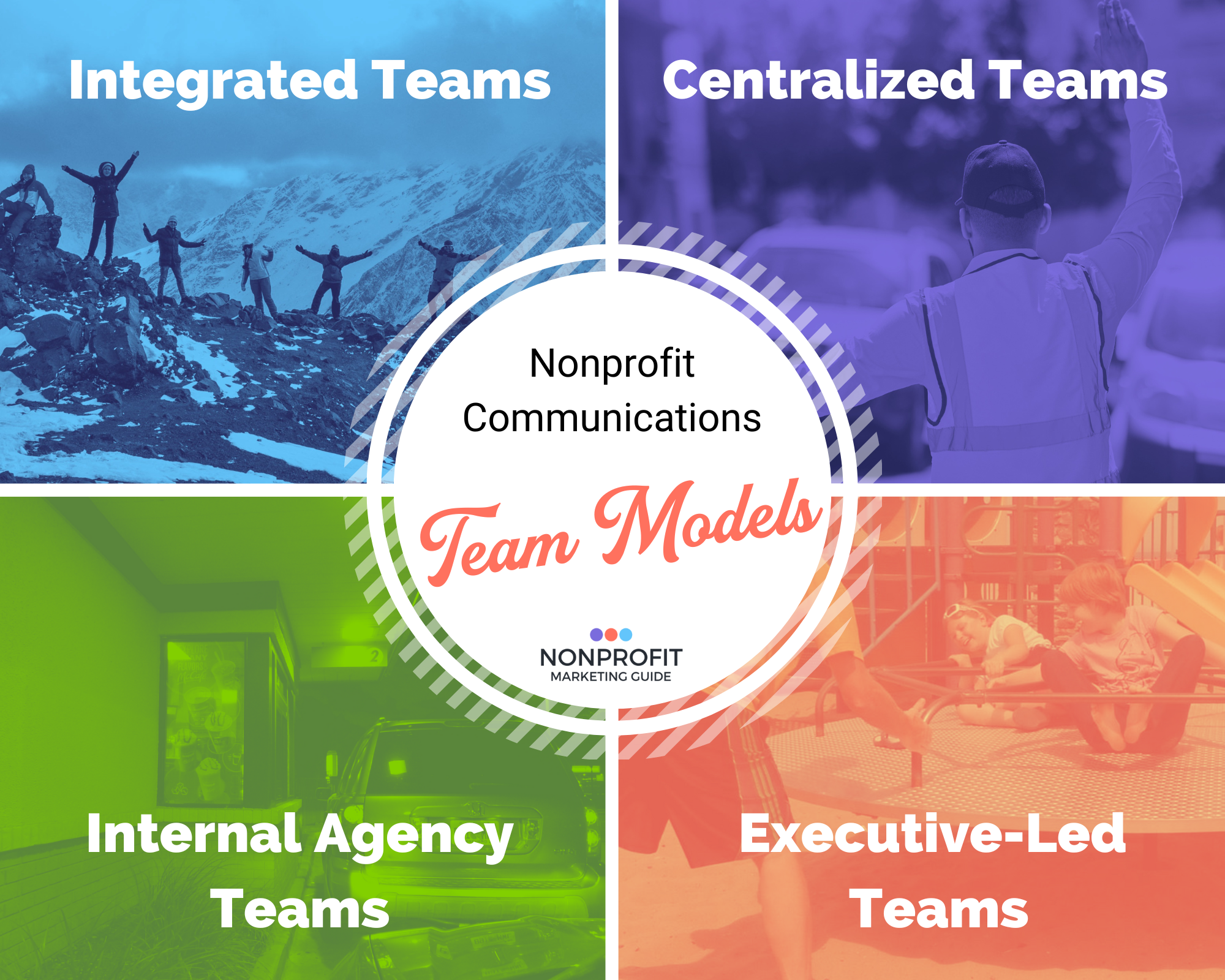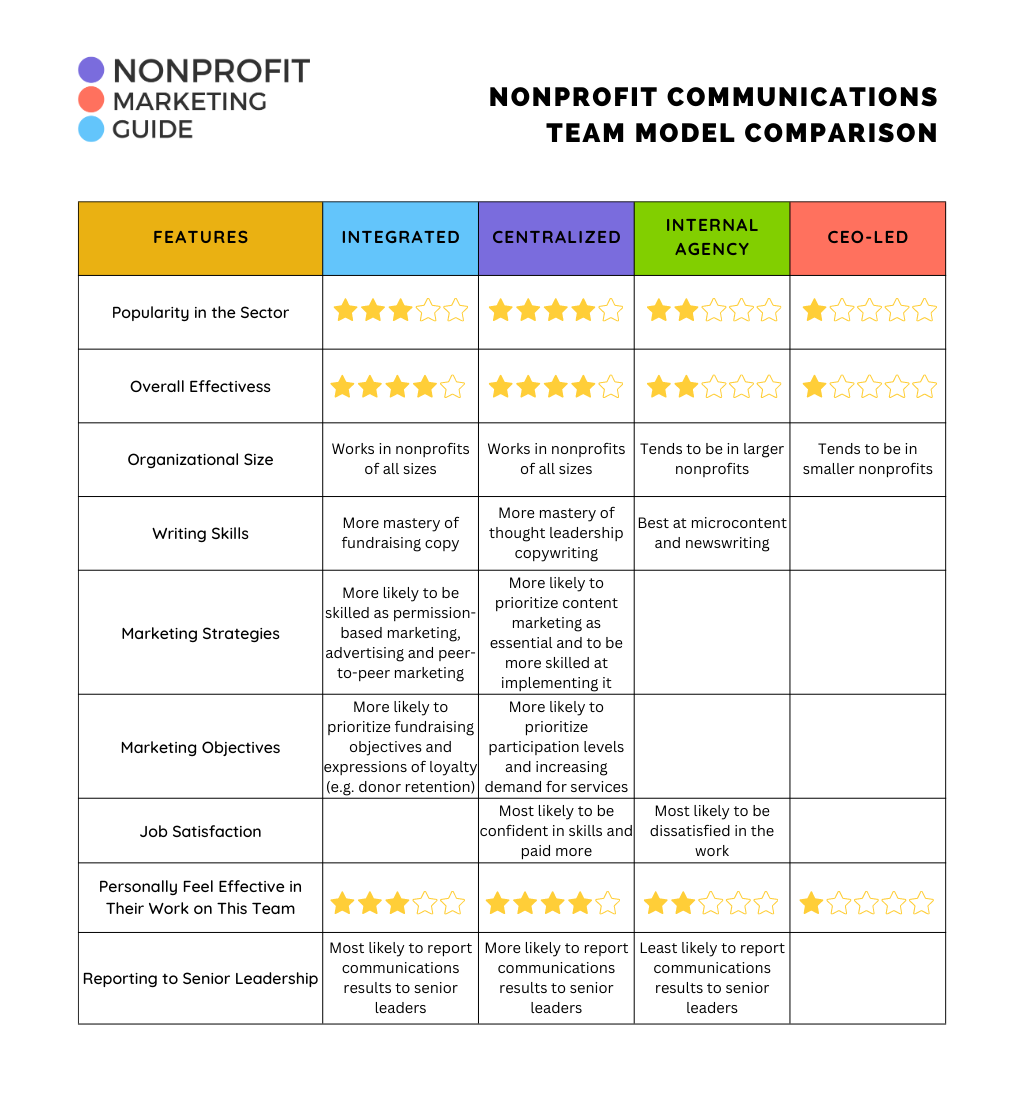
,,
As the communications roles and responsibilities grow in nonprofits, both staff and managers will question the function of the communications team within the organization. Where does it belong, and what does it do? How is that decided? In other words, which communications team model should we follow?
We’ve found that where the communications team sits in the organization chart isn’t what’s most important. What’s most important is who decides the communications team’s workload.
We began researching nonprofit communications team models in 2017 and have continued investigating how they work and what is most effective since then.
The Four Communications Team Models, Defined
When we first conducted this research in 2017, the distribution of team models with fairly equal.
Since then, we have seen more centralized and integrated teams. These two models make up about two-thirds of all nonprofit communications teams. Internal agency teams and executive-led teams make up the remaining third.
Integrated Teams
- Communications and fundraising staff work on an integrated team and jointly decide on the communications workload.
- Integrated teams merge multiple organizational goals and priorities (e.g., marketing and fundraising, or marketing and advocacy) and jointly determine shared objectives and workloads.
- This team will work to fully integrate and balance other non-fundraising communications responsibilities with its primary fundraising goals.
- It can be a single person serving as the communications & development director, but it often includes multiple team members.
- A favorite metaphor for integrated teams: A group of hikers climbing a mountain and jointly planting the team flag.
Centralized Teams
- Communications staff set the communications/marketing strategy and define their own workload.
- This team balances and prioritizes the needs of all parts of the organization. It unifies the nonprofit’s editorial calendar and most effectively combines nonprofit strategic and tactical best practices across the organization.
- Works well when funding comes from large grants, fees, or major donors rather than many individual donors.
- Works well with a “separate but equal” development department where development works with a specific segment of individual donors, and the communications team largely serves the organization’s mission-oriented goals.
- Just as likely as integrated teams to be considered strategic partners to programmatic leaders.
- It can be a single communications director or a team of several people.
- A favorite metaphor for centralized teams: A traffic cop or air traffic controller who manages the ebb and flow, with the ability to slow some people down and speed others up.
Internal Agency Teams
- Communications staff are a tactical “internal agency” whose workload is determined by other departments needing work done.
- Work requests come in with the expectation that they will be assigned immediately, with little discussion about other conflicting priorities.
- Internal agency teams tend to focus more on brand consistency and to think of themselves as content creators rather than strategic partners.
- Tends to be either very small teams buried deep in the organizational structure with little strategic input OR larger teams of skilled content creation specialists (writers, designers, videographers, editors) at larger nonprofits
- A favorite metaphor for internal agency teams: Drive-through windows
Executive-Led Teams
- Communications staff work directly for the CEO, executive director, or the senior fundraising executive who determines the workload.
- Tend to be smaller, understaffed teams, typically a single person with or without additional part-time help.
- Typically the executive has limited or no marketing or communications expertise.
- More likely to focus on PR, events, and administrative tasks.
- Very likely feels scattered with frequent changes in direction.
- A favorite metaphor for internal agency teams: Trying to hold tight and stay on a merry-go-round spinning way too fast
Effectiveness of the Four Communications Team Models
Integrated teams and centralized teams consistently rank themselves as more effective than internal agency teams, with executive-led teams coming in last. This order holds true regardless of how we have gauged effectiveness over the years. These measures include scores on various quizzes for marketing maturity, how strategic they feel, and how capable they feel in accomplishing their goals.
Both integrated and centralized teams outperform internal agency or executive-led teams significantly on job satisfaction and employee retention as well. The following chart summarizes some additional differences.

Why We Recommend Integrated or Centralized Communications Team Models
In general, we recommend that internal agency teams work on shifting to the centralized team model. If led by a fundraising executive, those teams should work on becoming an integrated team. Teams led by the CEO can go either way, depending on the balance between fundraising and other communications goals.
This transition is not just about the effectiveness of your communications. It’s also about your staff satisfaction and retention. Staff on centralized and integrated teams are much more likely to report that they are extremely effective in their work and are happier at work by several different measures.
Why Internal Agency and Executive-Led Teams Tend to Be Less Effective
Internal Agency Teams
The communications staff workload is determined by others who submit work requests or needs. These teams typically have very little say in communications strategy and are viewed as order takers. While team members can often enforce brand standards and tactical best practices as technical experts in graphic design and digital marketing, for example, they often have no recourse when asked to do work that conflicts with other organizational priorities.
The work of internal agency teams frequently suffers because leaders within various parts of the organization fail to coordinate communications strategy and editorial calendars at the executive level. This creates both conflict and many missed opportunities for internal collaboration and efficiency.
Internal agency team members typically feel isolated and less valued and respected by their programmatic and development co-workers and supervisors.
Executive-Led Teams
Communications staff work in service of top executives who determine the workload. This team structure is most often found in smaller organizations with a single communications staff
member who may only do communications part-time. It’s also found in larger organizations with executive directors who either fail to delegate well or treat communications staff more like executive assistants.
The effectiveness of executive-led team members suffers because they often feel like the direction they receive is constantly changing, with little strategic focus, consistency, or editorial planning.
When the executive is in charge of fundraising, communications staff often feel like all the non-fundraising communications — which can be significant — are dumped on them, but without leadership understanding or support for the work. These staff members often feel like they are failing to meet the communications expectations of programmatic and executive leaders because they report to a development executive who minimizes those other requests in favor of fundraising goals. Development leaders also sometimes downplay the need for communications expertise on branding, community engagement, and issue awareness.
Making Your Integrated or Centralized Teams Even More Effective
If you already use an effective team model, what can you do to be even more effective? Let’s look at some of the differences between the most and least effective teams in these two models.
Biggest Differences Between Effective and Ineffective Integrated Teams
- Collaboration within the team was much better.
- Clarity about responsibilities and authority was much better.
- The working relationship with the executive director was exceptional (rather than merely functional)
- They have a specific budget for external communications expenses.
Biggest Differences Between Effective and Ineffective Centralized Teams
- The ability to focus on the important over the urgent was better.
- Staff were much more likely to say they are very capable and confident in their abilities.
- Clarity about responsibilities and authority was much better.
- The working relationship with the executive director was exceptional (rather than merely functional)
- They have a specific budget for external communications expenses.
For more, also see Nonprofit Communications or Marketing Teams: Everything You Need to Know.
Need more help with team models? Join our Free Membership to access our Private Community with dedicated spaces to managing your team, working with others, and more.





